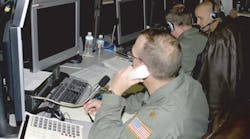By J.R. Wilson
The notion of close air support (CAS) is adapting to take maximum advantage of fast-moving, widely dispersed ground forces, and the proliferation of smart munitions on manned combat aircraft, unmanned aerial vehicles (UAVs), artillery, and mortars.
With new high-precision rounds planned for mortar and artillery units, CAS in the future may not even come from an aircraft — in which case the "A" may stand for artillery or the "Air" element may refer to flying shells.
"The Air Force programs are interoperable with the other services, so we are going to a standard message configuration, making it immaterial if the responding platform is Air Force, Navy, or Marine. It does no good to do service-specific any longer," says Air Force Col. Jimmy Ruth, chief of the Command and Control Battle Management Operations Division at Headquarters U.S. Air Force in Washington.
Also playing an important role is the new Joint Tactical Radio System, which will eliminate the need to address each weapon and weapon delivery system separately. U.S. military officials are developing procedures to consolidate calls for close air support through a Joint Chiefs of Staff group called the Joint CAS Steering Committee. "The planning and preparation make us more efficient in the way we deliver air power to the ground commander," Ruth explains
A key factor in that chain is training aircrews and ground forces at all levels of command. To accomplish that, experts are developing a joint high-fidelity simulations capability that will train operators throughout the command-and-control process, from shooters on up, to work in a variety of theater environments.
"We are developing procedures to work in-depth, using UAVs and other sensors to identify the targets and CAS procedures to direct aircraft to them," Ruth says. "We're working toward moving from the virtual to the live training aspect or combining them."
That happened in a joint exercise last January at the National Training Center at Fort Irwin, Calif., that mixed live and virtual simulations. The exercise involved Army ground forces, naval gunfire, Marine ground and air, special operations, and Air Force aircraft. The exercise used a combined air operations center at Nellis Air Force Base, Nev., and close-air-support elements from both bases as well as the Marine Air Ground Task Force Training Command at Twentynine Palms, Calif.
Ground forces seeking fire support will rely on their embedded Tactical Air Control Party (TACP) — usually a two-man team comprising one TAC and one battalion air liaison officer. Equipped with vehicle-mounted communications pallets, manpack radios, and digital communications devices, the TACP maintains contact with the ground forces it supports as well as aircraft operating in the area, aerospace command-and-control agencies, intelligence, surveillance, and reconnaissance agencies.
The TACP-Modernization effort will provide a technology refresh by adding/replacing manpack radios, a laser range finder, computers and software, and vehicular radios. The laser range finder helps locate targets and friendly forces in daylight and at night, and will integrate with other components.
Chief Master Sergeant Steven Buhrow, The Air Force's TACP functional area manager, says a newly developed TAC kit, including mission computer and software, underwent a spiral fielding in January for the F-16 Block 40 and F/A-18C/D aircraft.
With the release of the Joint Tactical Radio System, forces will have tactical datalink capability, which brings the TAC into the tactical datalink network, he says. "So you move away from voice to digital nine-line information to the aircrew, which can confirm and accept it digitally. The TAC on the ground then will see what targets the aircraft are pursuing on his digital map display and deconflict that with friendly units. He also will be able to filter out and pass up the closest friendlies to the target."
That approach also will eliminate what is known in the Air Force as a Fat Finger Exercise — taking firing coordinates verbally from the ground TAC, writing them on a kneepad while trying to fly the aircraft and avoid hostile fire, then keying them into the aircraft's computer, significantly increasing the possibility of a mistake that could lead to a "friendly fire" event.
The Naval Strike and Air Warfare Center at Fallon Naval Air Station, Nev., is responsible for Navy CAS training, which Capt. Dan Dixon, head of the center's strike department and former head of Fallon's Top Gun school, says has become an increasingly large part of naval air operations. During the second Persian Gulf War of 2003 (Gulf War II), for example, about three-quarters of all Navy and Marine air missions were CAS.
"We support the Army, Marines, and special ops land components, and train a lot to make sure we have the readiness for that mission," he says. Primarily the Navy uses the F/A-18C/D Hornet strike fighter, the F/A-18 E/F Super Hornet jet bomber, and the F-14 Tomcat jet fighter for CAS. "We can use a variety of weapons, from general purpose gravity bombs to laser-guided — and even 20-mm guns as a backup, he says.
The next generation of Air Force and Navy combat aircraft — the F/A-22 Raptor and F-35 Joint Strike Fighter — also will do close air support, but with a lot more automation including full digital data exchange, possibly even pictures of specific targets or sites, as well as new smart weapons.
"As new weapons come along, we have to make sure the procedures for using them in CAS keep up, especially with respect to avoiding fratricide," Dixon says. "The guy on the ground decides now close we come and, even with more precise weapons, it's no closer than before."
With new platforms, weapons, radios, and data communications, the requirement for joint solutions is greater than ever. A document was signed in 2003 standardizing procedures, training, voice communications by radio, and so on across all the services. With everyone using the same format to exchange information, all aircraft — regardless of service — can better support ground forces with less worry about confusion.
That same level of standardization is being applied to allied efforts as well, reducing the possibility of fratricide when supporting a multilingual coalition force, such as was used in Gulf War II. Dixon estimates America's primary coalition partners are probably 95 percent standardized with U.S. joint service protocols. That includes using English as the standard for all transmissions.
"The problem was the ground-based terminology, which was considerably different, along with the sequence in which information is transmitted — such as target elevation versus target position. They were doing that the opposite of how we did, but now we're all using the same approach," Dixon relates. "From five years ago, CAS is a larger part of the training today, but it has been relatively consistent in the past five years. All that's needed now is making sure all aircrews, joint and coalition, are using the same procedures."
While the Army has always relied on the Air Force — and, more recently, the Navy — for CAS, the Marines have relied primarily on their own air power and on the Navy. At the Marine Corps Warfighting Laboratory, part of the Marine Corps Combat Development Command at Quantico Marine Base, Va., experts are developing common equipment, software, and concept of operations as the responsibility for CAS expands out to all four services.
"We're trying to take advantage of technologies that allow one man on the field to talk to multiple platforms across multiple services," explains Lt. Col. Bryan McKinney, project officer for the Target Handoff System (Experimental) or THS(X).
"The Joint Terminal Air Controller will allow him to do that. All the guy on the ground wants is fire support — he doesn't care who provides it or how, so long as it is accurate and on time," McKinney says. "The guy delivering only cares about hitting the target and not having an incident of fratricide. That makes combat ID a critical element in all these systems and the color of the uniform irrelevant."
McKinney says the Marines are working to develop ways in which current hardware can combine with new software Marine ground forces call for CAS, naval fire support, or artillery quickly and easily. They began with the Marines' own AV-8B Harrier jump jets and F/A-18 fighters, but have completed ground testing for USAF F-16 Block 40 aircraft and are working on the Army's AH-64 Apache helicopter as well as Air Force F-15E fighters and B-52 bombers. While acknowledging the use of the B-52 for CAS is controversial, even within the Air Force, he says any aircraft that can carry a Joint Direct Attack Munition can program the bomb with a 10-digit grid coordinate and put it on target.
That was first demonstrated under fire in Afghanistan, where 2,000-pound bombs rarely missed their targets by more than 30 meters and were well within that range more than 95 percent of the time. During World War II, the same type of bomb in a "dumb" mode without modern precision guidance tended to land a quarter of a mile or more from its target, thus creating the need to "carpet bomb."
The biggest problem in precision CAS is not just building a future system, McKinney says, but one that will tie into all the legacy systems still in service — and likely to remain in service for some time to come.
"The difficult part is writing software that recognizes what it is talking to," McKinney says. "When an aircraft checks in, the guy on the ground can read who it is and what flight it is, verbally as well as digitally. At that point, the computer takes the information and goes from there — he doesn't have to do anything. The idea is to keep it simple.
In the final analysis, McKinney says, the modern digital battlefield has no such thing as digital CAS or digital call-for-fire or digital naval gunfire; there is only digital communications. CAS, call-for-fire, and naval gunfire are merely byproducts of digital communications.


